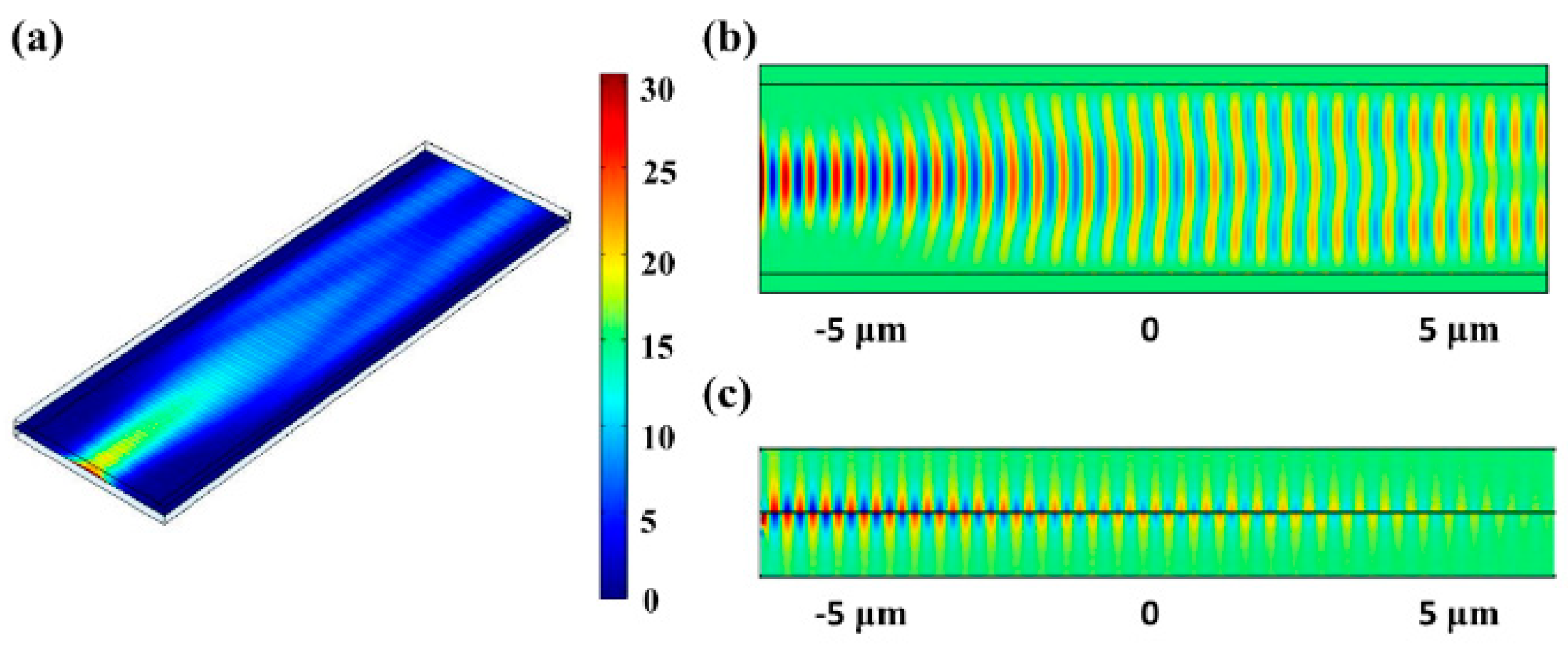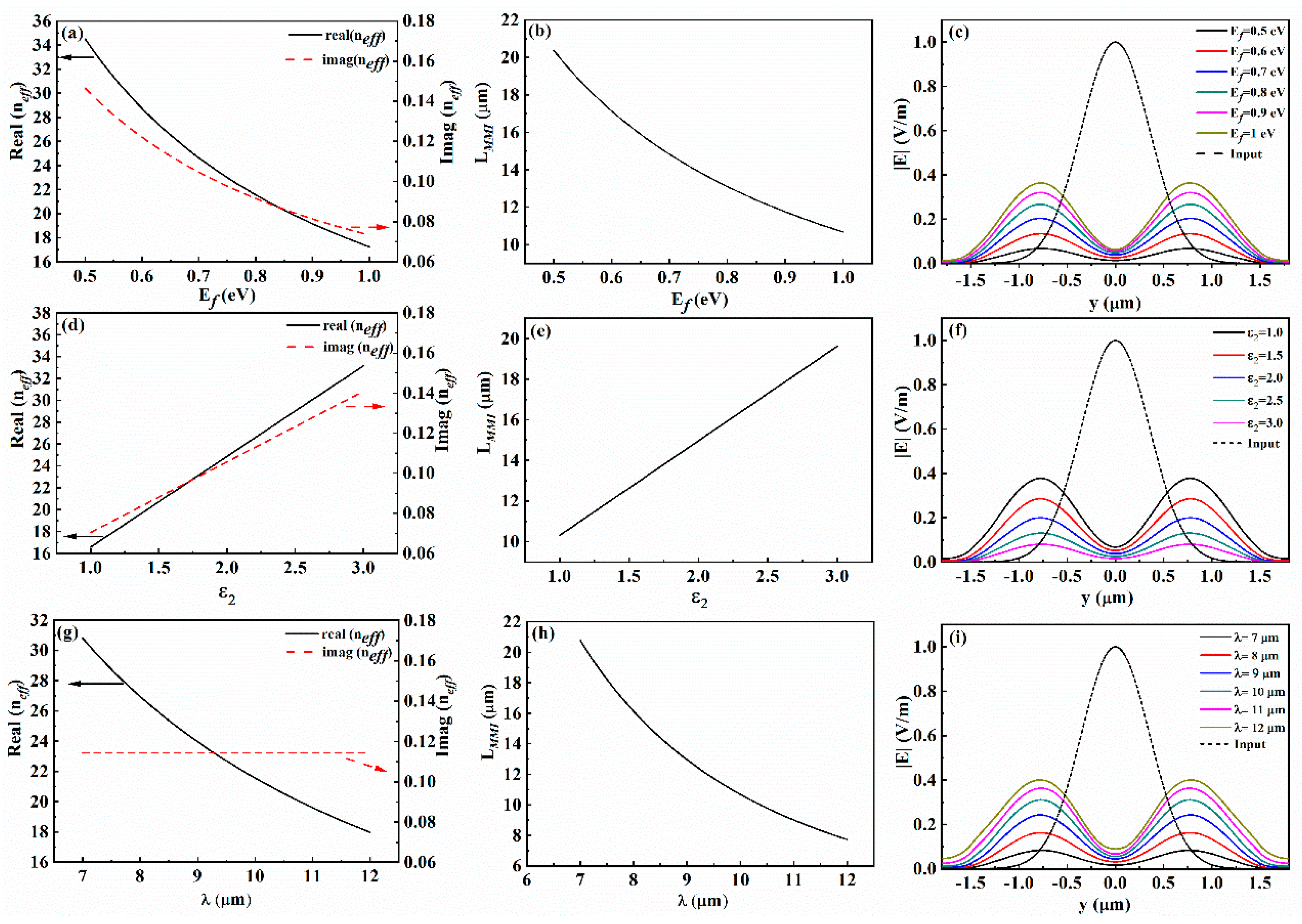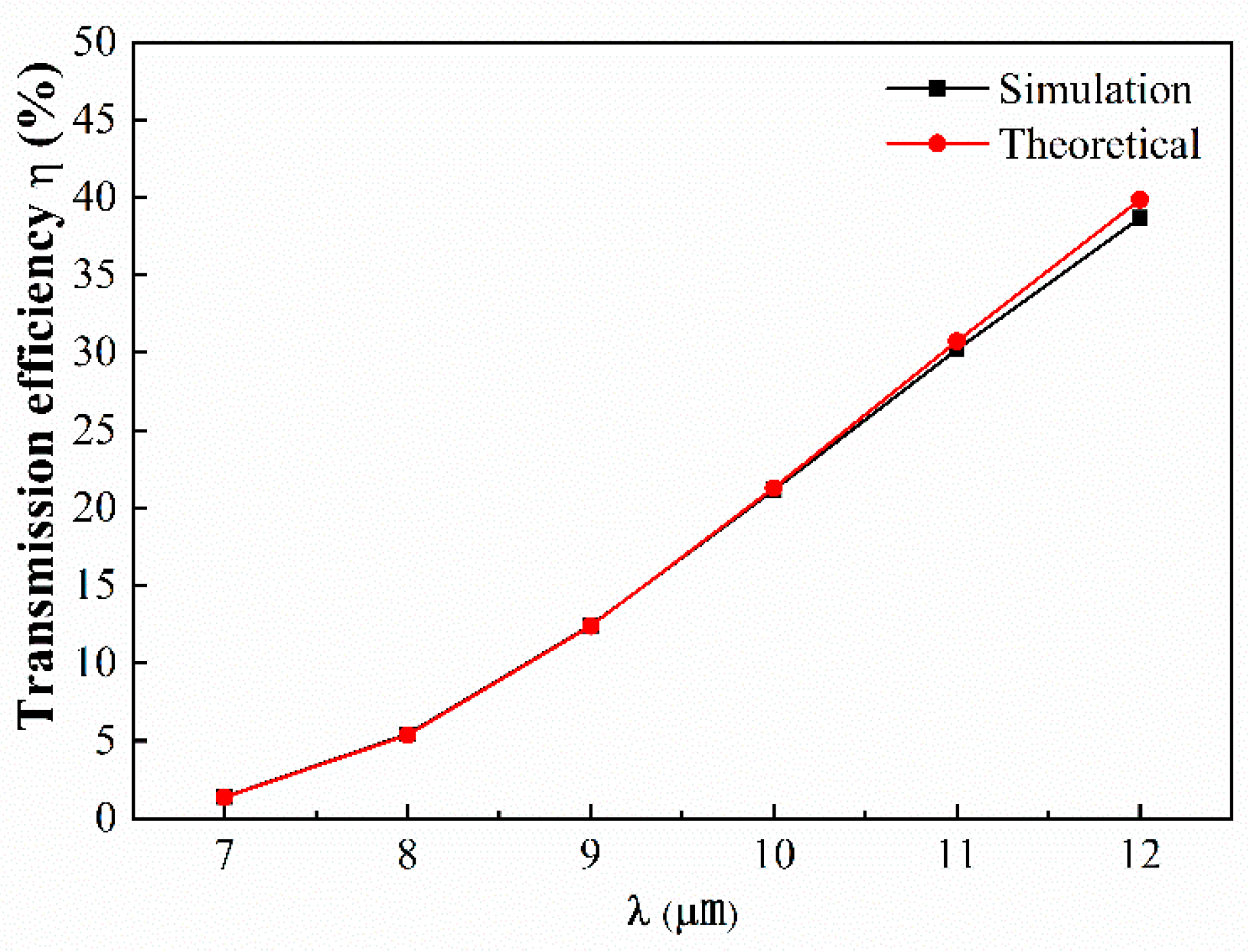1 × 2 Graphene Surface Plasmon Waveguide Beam Splitter Based on Self-Imaging
Abstract
:1. Introduction
2. Model Introduction and Theoretical Analysis
3. Results and Discussion
4. Conclusions
Author Contributions
Funding
Data Availability Statement
Conflicts of Interest
References
- Lu, L.; Zhao, T.T.; Chen, L.; Wang, C.Y.; Zhou, Z.Q.; Ren, X.F. The influence of single layer MoS2 flake on the propagated surface plasmons of silver nanowire. Nanotechnology 2022, 33, 155401. [Google Scholar] [CrossRef] [PubMed]
- Brongersma, M.L.; Shalaev, V.M. The case for plasmonics. Science 2010, 328, 440–441. [Google Scholar] [CrossRef] [PubMed]
- Wan, Y.; Liu, Q.; Xu, Z.H.; Li, J.Z.; Wang, H.J.; Xu, M.Y.; Yan, C.L.; Song, X.H.; Liu, X.; Wang, H.Q. Interface engineering enhanced g-C3N4/rGO/Pd composites synergetic localized surface plasmon resonance efect for boosting photocatalytic CO2 reduction. Carbon Lett. 2024, 34, 1143–1154. [Google Scholar] [CrossRef]
- Lu, L.; Wang, C.Y.; Ngiejungbwen, A.L.; Zhang, L.; Zhao, T.T.; Chen, D.F.; Ren, X.F. Dynamically controlled nanofocusing metalens based on graphene-loaded aperiodic silica grating arrays. Opt. Express 2022, 30, 5304–5313. [Google Scholar] [CrossRef]
- Epstein, I.; Alcaraz, D.; Huang, Z.; Pusapati, V.V.; Hugonin, J.P.; Kumar, A.; Deputy, X.M.; Khodkov, T.; Rappoport, T.G.; Hong, J.Y. Far-field excitation of single graphene plasmon cavities with ultracompressed mode volumes. Science 2020, 368, 1219–1223. [Google Scholar] [CrossRef]
- Huang, Z.Y.; Feng, Y.C. Tunable Plasmonic Filter Based on Improved Quasiperiodic Structure. Plasmonics 2024, 19, 1649–1657. [Google Scholar] [CrossRef]
- Wang, X.; Liu, G.; Xia, S.; Meng, H.; Shang, X.; He, P.; Zhai, X. Dynamically tunable Fano resonance based on graphene metamaterials. IEEE Photonics Technol. Lett. 2018, 30, 2147–2150. [Google Scholar] [CrossRef]
- Zhuo, S.; Zhou, F.; Liu, Y.; Liu, Z.; Zhang, X.; Luo, X.; Qin, Y.; Yang, G.; Ji, C.; Zhou, Z. Terahertz multimode modulator based on tunable triple-plasmon-induced transparency in monolayer graphene metamaterials. J. Opt. Soc. Am. A 2022, 39, 594–599. [Google Scholar] [CrossRef]
- Du, L.; Tang, D. Manipulating propagating graphene plasmons at near field by shaped graphene nano-vacancies. J. Opt. Soc. Am. A 2014, 31, 691–695. [Google Scholar] [CrossRef]
- Zhang, D.; Zhang, L. Tunable terahertz dual-band band-stop filter based on surface magnetoplasmons in graphene sheet array. Opt. Laser Technol. 2020, 132, 106484. [Google Scholar] [CrossRef]
- Christensen, J.; Manjavacas, A.; Thongrattanasiri, S.; Koppens, F.H.; García De Abajo, F.J. Graphene plasmon waveguiding and hybridization in individual and paired nanoribbons. Acs Nano 2012, 6, 431–440. [Google Scholar] [CrossRef] [PubMed]
- Tao, J.; Yu, X.; Hu, B.; Dubrovkin, A.; Wang, Q.J. Graphene-based tunable plasmonic Bragg reflector with a broad bandwidth. Opt. Lett. 2014, 39, 271–274. [Google Scholar] [CrossRef] [PubMed]
- Yang, J.; Xin, H.; Han, Y.; Chen, D.; Zhang, J.; Huang, J.; Zhang, Z. Ultra-compact beam splitter and filter based on a graphene plasmon waveguide. Appl. Opt. 2017, 56, 9814–9821. [Google Scholar] [CrossRef] [PubMed]
- Zhuang, H.; Kong, F.; Li, K.; Wang, Y. A dielectric-thickness-adjusting method for manipulating graphene surface plasmon polariton. Plasmonics 2017, 12, 605–610. [Google Scholar] [CrossRef]
- Ding, F.; Deshpande, R.; Meng, C.; Bozhevolnyi, S.I. Metasurface-enabled broadband beam splitters integrated with quarter-wave plate functionality. Nanoscale 2020, 12, 14106–14111. [Google Scholar] [CrossRef]
- Kocer, H.; Durna, Y.; Kurt, H.; Ozbay, E. Dynamic beam splitter employing an all-dielectric metasurface based on an elastic substrate. Opt. Lett. 2020, 45, 3521–3524. [Google Scholar] [CrossRef]
- Xu, W.; Zhu, Z.; Liu, K.; Zhang, J.; Yuan, X.; Lu, Q.; Qin, S. Dielectric loaded graphene plasmon waveguide. Opt. Express 2015, 23, 5147–5153. [Google Scholar] [CrossRef]
- Xiao, G.L.; Zhou, S.T.; Yang, H.Y.; Lin, Z.X.; Li, H.; Liu, X.P.; Chen, Z.H.; Sun, T.Y.; Wangyang, P.H.; Li, J.Q. Dynamically Tunable and Multifunctional Polarization Beam Splitters Based on Graphene Metasurfaces. Nanomaterials 2022, 12, 3022. [Google Scholar] [CrossRef]
- Wei, M.; Xu, Q.; Wang, Q.; Zhang, X.; Li, Y.; Gu, J.; Tian, Z.; Zhang, X.; Han, J.; Zhang, W. Broadband non-polarizing terahertz beam splitters with variable split ratio. Appl. Phys. Lett. 2017, 111, 071101. [Google Scholar] [CrossRef]
- Ding, F.; Wang, Z.; He, S.; Shalaev, V.M.; Kildishev, A.V. Broadband high-efficiency half-wave plate: A supercell-based plasmonic metasurface approach. Acs Nano 2015, 9, 4111–4119. [Google Scholar] [CrossRef]
- Feng, S.; Xiao, T.H.; Gan, L.; Wang, Y.Q. Tuning beam power-splitting characteristics through modulating a photonic crystal slab’s output surface. J. Phys. D Appl. Phys. 2016, 50, 025107. [Google Scholar] [CrossRef]
- Florous, N.J.; Saitoh, K.; Koshiba, M. Theoretical investigation of photonic crystal waveguide splitters incorporating ultralow refractive index metallic nanowires. IEEE Photonics Technol. Lett. 2005, 17, 2313–2315. [Google Scholar] [CrossRef]
- Hong, L.; Xiao, S.; Deng, X.; Pu, R.; Shen, L. High-efficiency tunable t-shaped beam splitter based on one-way waveguide. J. Opt. 2018, 20, 125002. [Google Scholar] [CrossRef]
- Qiu, P.; Qiu, W.; Lin, Z.; Chen, H.; Ren, J.; Wang, J.X.; Kan, Q.; Pan, J.Q. Investigation of beam splitter in a zero-refractive-index photonic crystal at the frequency of Dirac-like point. Sci. Rep. 2017, 7, 9588. [Google Scholar] [CrossRef]
- Yasa, U.G.; Giden, I.; Turduev, M.; Kurt, H. Polarization splitting phenomenon of photonic crystals constructed by two-fold rotationally symmetric unit-cells. J. Opt. 2017, 19, 095005. [Google Scholar] [CrossRef]
- Yasa, U.G.; Turduev, M.; Giden, I.H.; Kurt, H. High extinction ratio polarization beam splitter design by low-symmetric photonic crystals. J. Lightwave Technol. 2017, 35, 1677–1683. [Google Scholar] [CrossRef]
- Kaliberda, M.E.; Lytvynenko, L.M.; Pogarsky, S.A.; Sauleau, R. Excitation of guided waves of grounded dielectric slab by a THz plane wave scattered from fnite number of embedded graphene strips: Singular integral equation analysis, IET Microw. Antennas Propag. 2021, 15, 1171–1180. [Google Scholar]
- Luxmoore, I.J.; Liu, P.Q.; Li, P.; Faist, J.; Nash, G.R. Graphene–metamaterial photodetectors for integrated infrared sensing. ACS Photonics 2016, 3, 936–941. [Google Scholar] [CrossRef]
- Slrmacl, Y.D.; Gomez, A.B.; Pertsch, T.; Schmid, J.H.; Cheben, P.; Staude, L. All-Dielectric Huygens’ Meta-Waveguides for Resonant Integrated Photonics. Laser Photonics Rev. 2023, 17, 2200860. [Google Scholar]
- Luque, J.M.; Sánchez, P.A.; Hadij, E.A.; Ortega, M.A.; Wangüemert, P.J.G.; Schmid, J.H.; Cheben, P.; Molina, F.I.; Halir, R. A review of silicon subwavelength gratings: Building break-through devices with anisotropic metamaterials. Nanophotonics 2021, 10, 2765–2797. [Google Scholar] [CrossRef]
- Yuan, G.H.; Wang, P.; Lu, Y.H.; Ming, H. Multimode interference splitter based on dielectric-loaded surface plasmon polariton waveguides. Opt. Express 2009, 17, 12594–12600. [Google Scholar] [CrossRef] [PubMed]
- Kou, Y.; Chen, X.F. Multimode interference demultiplexers and splitters in metal-insulator-metal waveguides. Opt. Express 2011, 19, 6042–6047. [Google Scholar] [CrossRef] [PubMed]




Disclaimer/Publisher’s Note: The statements, opinions and data contained in all publications are solely those of the individual author(s) and contributor(s) and not of MDPI and/or the editor(s). MDPI and/or the editor(s) disclaim responsibility for any injury to people or property resulting from any ideas, methods, instructions or products referred to in the content. |
© 2024 by the authors. Licensee MDPI, Basel, Switzerland. This article is an open access article distributed under the terms and conditions of the Creative Commons Attribution (CC BY) license (https://creativecommons.org/licenses/by/4.0/).
Share and Cite
Lu, L.; Xu, P.; Zhang, L.; Le, J.; Chen, D. 1 × 2 Graphene Surface Plasmon Waveguide Beam Splitter Based on Self-Imaging. Nanomaterials 2024, 14, 1538. https://doi.org/10.3390/nano14181538
Lu L, Xu P, Zhang L, Le J, Chen D. 1 × 2 Graphene Surface Plasmon Waveguide Beam Splitter Based on Self-Imaging. Nanomaterials. 2024; 14(18):1538. https://doi.org/10.3390/nano14181538
Chicago/Turabian StyleLu, Liu, Peng Xu, Liang Zhang, Jia Le, and Daifen Chen. 2024. "1 × 2 Graphene Surface Plasmon Waveguide Beam Splitter Based on Self-Imaging" Nanomaterials 14, no. 18: 1538. https://doi.org/10.3390/nano14181538





